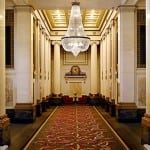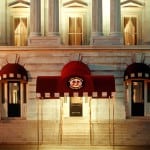Skift Take
Why did InterContinental Hotels Group want Kimpton so much? Here's a bit of history to explain where its interest came from.
- Jasper’s Corner Tap & Kitchen, San Francisco
- FireFly Restaurant, Washington D.C.
- FireFly Restaurant, Washington D.C.
- Surfcomber Miami South Beach – A Kimpton Hotel
- Canary Hotel, Santa Barbara
- Eventi, New York City
- FireSky Resort & Spa Scottsdale
- Hotel Palomar Phoenix
- Jackson 20 Restaurant, Alexandria
- Zentan Restaurant, Washington D.C.
- Hotel Monaco Baltimore
- Hotel Washington D.C.
- The George – A Kimpton Hotel, Washington D.C.
- Custom Kimpton Hotels bike
While hotels have always been gateways to a destination, the boutique/design/lifestyle hotel surge in the late 20th century elevated the urban hotel into a destination in and of itself.
The idea of a neighborhood hotel acting as a community portal with a strong local following became a market differentiator for an exciting batch of new hotel brands.
Read More: InterContinental Hotels Group to Acquire Kimpton Hotels for $430 Million
Within the last decade, the large global hotel brands have jumped on the trend, and there’s also a new wave of mid-market brands reimagining the localism trend for middle income brackets and secondary markets. Now, throughout the hospitality industry, there’s widespread realization that delivering a more immersive, layered travel experience for today’s more educated and connected traveler is, if not a necessity, a competitive advantage.
In the Beginning: Kimpton and Morgans Hotels
When Bill Kimpton launched his first Kimpton Hotel in San Francisco in 1981, and Ian Schrager and Steve Rubell unveiled their Morgans Hotel Group three years later in New York, they created the boutique hotel industry in North America.
These maverick hoteliers developed properties with a strong sense of place and individual identity.
When Bill Kimpton launched the Clarion Bedford Hotel in San Francisco in 1981, he created the boutique hotel industry in America. Since then, Kimpton Hotels & Restaurants has steadfastly maintained its early adopter status in terms of local design, locally-sourced F&B, corporate responsibility and community integration.
Many hospitality trends in the U.S. can be traced back to Kimpton, which now operates 60 hotels and a growing collection of independent restaurants across the country. Of those trends, the most significant is an unerring sense of place specific to a local neighborhood.
Kimpton, who suffered from depression, developed hotels that were an antidote to his melancholy and adverse reaction to monotony. He designed each property with a charming artistic flair similar to the small European hotels he had visited during his previous career as a financier. They were in stark contrast to the sterile, homogenous corporate hotels typical of that era in America.
Schrager and Rubell, meanwhile, had been successful nightclub proprietors in the 1980s. Following tax evasion charges and the advent of AIDs, the two men shifted into hospitality and brought their impresario skills with them. Their striking “design hotels” appealed to celebrities and social elites due to their avant garde art/furnishings, hip lobby bars and trendy music that spawned the concept of “lobby socializing.”
Most importantly, both Kimpton and Morgans designed and staffed their hotels to be kinetic social hubs in their particular communities.
The hotels became part of their community fabric because the creative design and quality of F&B attracted a significant following of local residents. Before Kimpton, hotel restaurants were for the most part utilitarian. In effect, the hotels became travel destinations in their own right, connecting visiting guests and local residents.
“From the start,” Kimpton told Hospitality Design magazine in 1999, “I wanted to create something unique, offering a European flavor, good value and a sense of fun. Whether you are traveling for work or pleasure, you often arrive tired or worried, and a hotel should lift your spirits, not put you to sleep as you step through the door.”
The local community mindset for which Kimpton is well known is manifested in myriad ways. For example, general managers lead bike tours for guests in Washington, D.C. through local neighborhoods. When employees at any of the hotels work extra hours, administrators send flowers or gift baskets to loved ones. In the 1980s, Kimpton was the first corporate hotel group to publicly support the LGBT community in San Francisco. And Kimpton placed a priority on local food long before local food became mainstream.
Another brand initiative, the Kimpton Wine Hour takes place at every hotel from 5-6pm daily in the lobbies, when GMs converse with guests while complimentary wine and craft beer is served. To give everyone something to talk about, concierges place iPads filled with fresh local destination information around the room.
Recently, most of the Kimpton properties have begun incorporating employee recommendations about local travel experiences on the hotel websites. Anyone from the GMs to custodial staff are asked to share their favorite hangouts, updated monthly, offering a highly curated array of destination insight at a variety of price points.
“Throughout Kimpton’s history, our most important initiative is called ‘Like a Local,’” says Mark Jennings, regional vice president, hotel operations mid-Atlantic for Kimpton Hotels. “We are always providing our personal recommendations for our guests on all of the cool things that we think they may not know about. That’s what people want, whether they’re international, domestic or drive-in. They really want something they feel they’re not going to get somewhere else.”
Kimpton operates two sub-brands—Monaco Hotels and Palomar Hotels—each with specific business models and design missions. “All of the rest are almost brands of one,” says Jennings. “Everytime we go through the initial design process, it is always with an eye towards, how does this tie in locally? What is important to this part of the city?”
Adding further to the destination-specific flavor, all of Kimpton’s restaurants are separate entities designed as standalone businesses.
“Over 80 percent of the business we get in all of our restaurants is local,” explains Jennings. “I can’t tell you how important it is to attract a local following. The local business and people driving in have kept us extremely busy.”
Have a confidential tip for Skift? Get in touch














